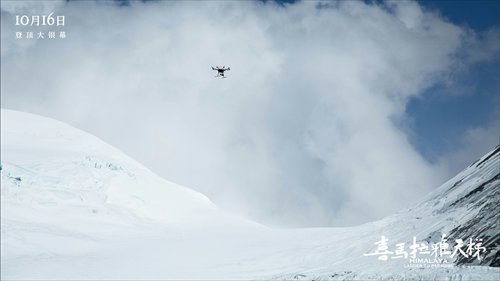
Himalaya: Ladder to Paradise is the first film in the world that uses aerial photographic shots taken at 6,800 meters on Mount Everest.
The documentary, Himalaya: Ladder to Paradise, is already a record breaker even before it opens officially. It is the first Chinese documentary about mountaineering shot in 4K resolution. It's the first film in the world that uses aerial photographic shots taken at 6,800 meters on Mount Qomolangma and it's also the first film to detail the process of climbing the mountain from the north side.
The documentary focuses on a group of Sherpas in Tibet bring trained-to-guide climbers up the legendary mountain. The film opens in cinemas throughout China on Friday.
A preview in Shanghai early this week attracted hundreds - most of whom were enthusiasts who had donated money to help make the movie. So it's possibly also the first Chinese mountaineering documentary completed through online fundraising.
On Weibo, fans of the film have been booking screenings so that the film will not be lost in a sea of commercial blockbusters when it opens.
This is not a formal, officially sanctioned documentary but rather the brainchild of idealistic academics who put themselves into different moviemaking roles (producers, screenwriters, directors) to create the work.
The 89-minute film is the product of four years of painstaking work by a multicultural team which included Han people, Tibetans and foreigners. They spent two years in preparation then a year filming it and finally a year editing the 45,000 feet of film shot.
A different approach
Co-director Xiao Han had just finished shooting a totally different documentary when he was asked by Lei Jianjun to join the Himalaya: Ladder to Paradise team. Xiao's previous film was a documentary, Lijiang Facebook, a film that followed seven couples in the southwestern China tourist city Lijiang which is notorious for its relaxed attitude to marital affairs and sex.
Lei, a co-producer of the film and an assistant professor at Tsinghua University, told Xiao, an assistant professor at the Zhejiang University of Technology, the proposed story line and persuaded him to come on board.
So in 2009, Lei went to Tibet to shoot initial footage of Mount Everest and, by chance, he visited the Tibet Mountaineering Guide School, the only school of its kind in Tibet. The school opened in 1999 and enrolls local students every two years from nearby counties. At the school Lei was asked by a Tibetan student if he could take something to his father, the only monk in the highest temple in the world - the Rongbuk Monastery which is found at 5,300 meters, beneath Mount Everest.
However, unlike his son who dreams of climbing Mount Everest, the monk believes these great mountains in Tibet are sacred and should be respected rather than "conquered" by humans.
"I was really deeply touched by this story and impressed by the very different choices of the people there," said Xiao. "At that exact moment I decided I wanted to make this film and do it properly.
"Out film is not about promoting mountaineering or criticizing it. It's just to reveal the reality about mountaineering, which links these young Tibetans, each of whom has their own stories and lives. And maybe audiences will think about themselves along with these young men," Xiao said.
The initial budget for the film was 1 million yuan ($157,600) which the two academics planned to shoot with their university students. But after research, they realized they would need more. After one managed to sell an apartment they found they had scraped together 5 million yuan and were ready to start the actual filming.
Keeping it stable
There were eight cinematographers in the team, four of them Tibetans. Tashi Wanggyal, who was a cameraman for BBC documentary series A Year in Tibet, served as a co-producer and director of photography for the film.
"For this film, I needed a cinematographer who could ensure the pictures were absolutely rock solid even though most were being filmed with handheld cameras. We even carried a camera tripod to the top of Mount Everest," said Tashi, who has more than 20-year experience filming documentaries.
To get perfect pictures at extreme altitudes, Tashi spent three months training two Tibetans as cameramen and they managed all the filming above 7,000 meters, including rare scenes of Tibetans leading climbers to the top of Mount Everest and a panning shot of stunning beauty from the world's highest point.
The cold temperatures were also a problem for the crew. "We had to wrap the cameras in thick covers to keep them working and, a lot of the time, we carried the equipment batteries inside our clothing keeping them warm and reducing the loss of electrical charge," Tashi told the Global Times.
For Tashi this film is personally special because it reflects the actual life of Tibetans now. There are no voice-overs or informative subtitles. Just scenes showing how these young Tibetans live.
Although obviously the excitement of climbing Mount Everest is a stunning moment, just as affecting are the moments the film spends with these young men and their families and friends, or the religious ceremonies they undertake.
"I think it's the special charm of this documentary that different people will see different things in it," Tashi said.
In the end, the film cost 13 million yuan to complete and the budget was eventually met with the help of brand sponsors and donations from more than 700 people in online fundraising.
A five-episode television documentary will be put together from the footage and Tashi said already seven major television channels, including the BBC and Al Jazeera, have expressed interest.


















































